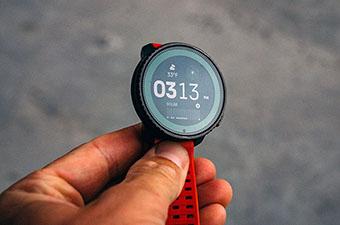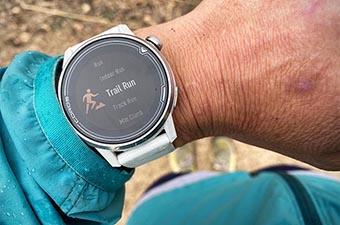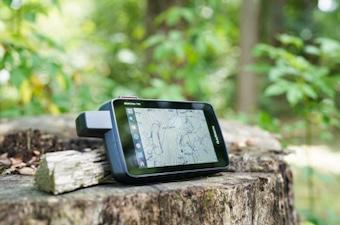Garmin Fenix 7 Pro Sapphire Solar
Price: $900
Weight: 2.6 oz. (42mm)
Battery: Lithium-ion and solar
Diameters: 42mm, 47mm, 51mm
What we like: A highly durable and accurate GPS watch with impressive battery life and a no-holds-barred feature set.
What we don’t: Expensive and overkill for most casual users.
See the Garmin Fenix 7 Pro Sapphire Solar
When it comes to GPS watches, few brands rival Garmin. Their venerable Fenix series has long been a favorite among long-distance runners, backcountry explorers, and everyday athletes alike. The Fenix 7 Pro delivers the premium tracking and navigation capabilities we’ve come to expect from Garmin, along with over 100 sport modes and convenient features like sleep tracking, daily training suggestions, endurance scores, and more. It’s built to be a versatile, high-performance companion for nearly any activity. I put the Sapphire Solar version of the Fenix 7 Pro to the test on multi-day backpacking trips in the Pacific Northwest, used it as my daily-driver while training for long-distance runs, and wore it to track rock climbing, canoeing, and cycling modes over the last year. Below I detail my experiences with the Fenix 7 Pro Sapphire Solar. To see how it stacks up to the competition, check out our articles on the best GPS watches and best fitness watches.
Table of Contents
- Battery Life
- GPS Accuracy
- Heart Rate Accuracy
- Activity Modes and Data Screens
- Display and User Interface
- Maps and Navigation
- Build Quality and Durability
- What We Like/What We Don't
- Comparison Table
- The Competition
Performance
Battery Life
As someone who remembers having to wear two watches during long races just to track the full duration, I’m blown away by the battery life of modern sport watches. Garmin’s Fenix 7 Pro is a standout in this category. Even the smallest model (42mm) delivers an impressive 11 days of battery life in basic smartwatch mode (the default mode, with no GPS tracking). While using GPS at full capacity (including tracking and maps) does reduce battery life, the 56-hour runtime is more than enough for most weekend backcountry trips. And the Fenix’s “Expedition Mode” is a great feature for extended wilderness use—by recording at intervals and disabling sensors and accessories, the watch can last up to 40 days without a charge. On top of that, the Fenix 7 Pro I tested has a built-in solar panel, meaning exposure to sunlight can boost battery life to 14 days in smartwatch mode.

A few additional battery-related features stood out in testing. The remaining battery display not only shows a percentage but also estimates the time left. When the battery runs low, the watch offers a “Battery Saver Mode” that disables certain functions (heart rate, sleep monitoring, body battery, etc.) to conserve power. Users can customize these settings through Garmin’s Connect app. And charging is a straightforward task: Plug the cord into the back, where it locks in securely—no need to babysit the connection—and the watch will let you know when it’s fully charged.
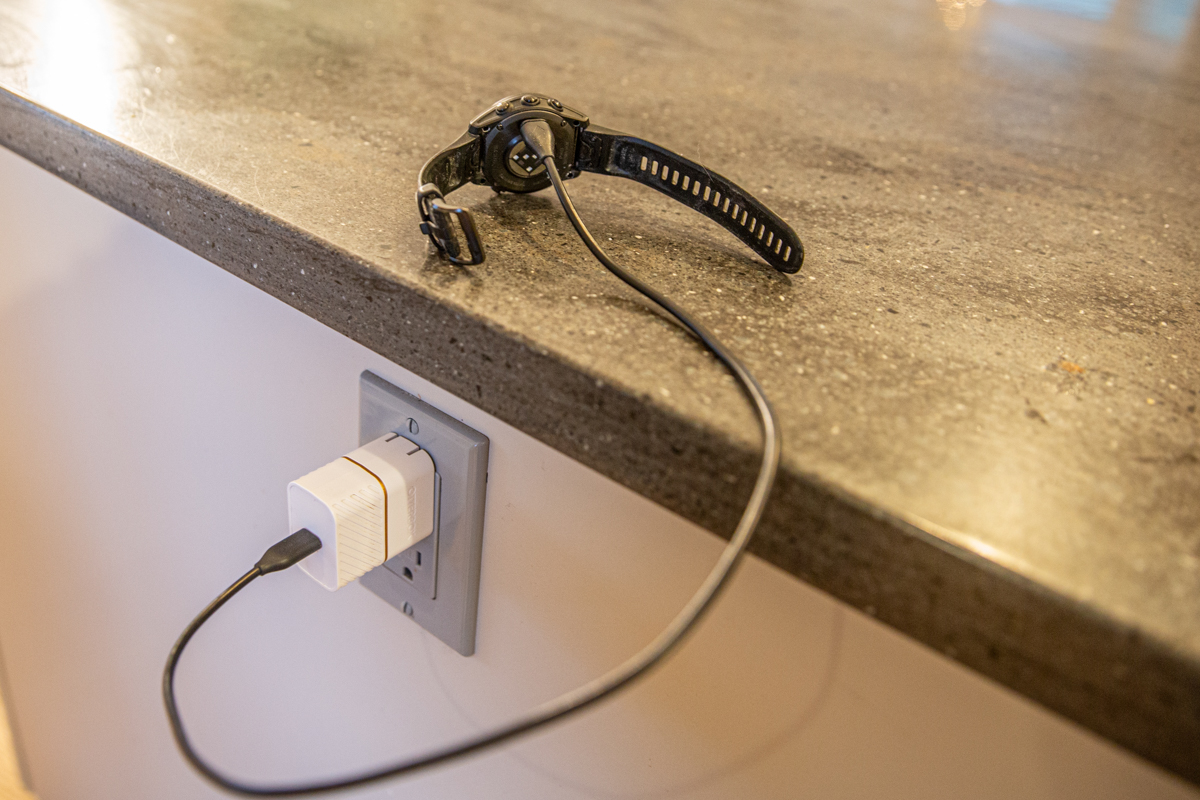
GPS Accuracy
The Fenix 7’s GPS function is one of the best I’ve come across. I was impressed by how quick the watch was able to connect to satellites, even in deep canyons and dense forests. It’s much faster than my Garmin inReach or Apple’s satellite connection featured in their newer iPhone models. Tracking is highly accurate: Reviewing my routes post-trip, I can see every tight switchback and minor trail deviation. On frontcountry runs, it consistently nailed the distance. Around my local track, for example, it recorded each lap precisely at 400 meters. It’s also worth noting here that the Fenix 7 Pro is also compatible with Garmin’s inReach ecosystem, allowing users to send SOS alerts and preset messages from the watch—an understated but potentially life-saving feature.

Heart Rate Accuracy
Having trained for decades with chest strap monitors, I was initially skeptical about wrist-based heart rate tracking, but the Fenix 7 has proven to be as reliable as most dedicated monitors thus far. In fact, I wore the Fenix 7 and a Polar heart rate monitor on a run and found that the Fenix responded more quickly to changes in intensity. The Fenix is outfitted with Garmin’s Elevate V5 optical heart rate sensor, which has more LEDs than the previous versions, enabling the watch to continue tracking your heart rate when the sensor is blocked or your wrist is bent.

The Fenix’s HR sensor not only tracks heart rate but also breathing rate, blood oxygen levels, HRV (heart rate variability) status, stress levels, and sleep metrics. Garmin also introduced a ECG feature in 2023 for detecting atrial fibrillation. As someone with a large left ventricle (aka “athlete’s heart”) and a history of Afib requiring cardioversion, this feature is invaluable. Though, it's worth noting that this function doesn't work if one's heart rate is below 50 beats per minute.

Activity Modes and Data Screens
Things start to get a bit overwhelming when it comes to the Fenix 7 Pro's activity modes. In fact, it seems like there is a mode for any activity. You want to go snorkeling? No problem. Table tennis? The Fenix’s got it. Cricket, MMA, lacrosse? It’s all there. At the time of publishing, the Fenix 7 Pro has over 100 activity modes to choose from (a number that can change with software updates). That said, I mainly stuck with the cycling (road, gravel, and mountain biking), paddling, backpacking, rock climbing (indoor and outdoor), pilates, and running modes.

Since I spent the most time using the running mode, I’m most familiar with its data. Not only does it track and display distance, heart rate, and pace data, but it can also record cadence, power, and stride length. It also has a “hill score” that measures hill endurance and strength and has gone so far as to warn me when I’m overworking my calves and achilles. While all of this data is accessible on the watch itself, I found it easier to digest on Garmin’s smartphone app.
It’s impossible to outline all of the activity modes and data that the Fenix 7 covers in this review, but there are a few other notable features to mention. The watch can provide several other metrics, such as endurance scores, fitness age, VO2 max, and body battery (which is based on rest, sleep, stress levels, and activity). The watch can also provide daily training suggestions and feedback on training loads. You can customize which data fields appear using the app, which I found useful in filtering out what I didn't need.
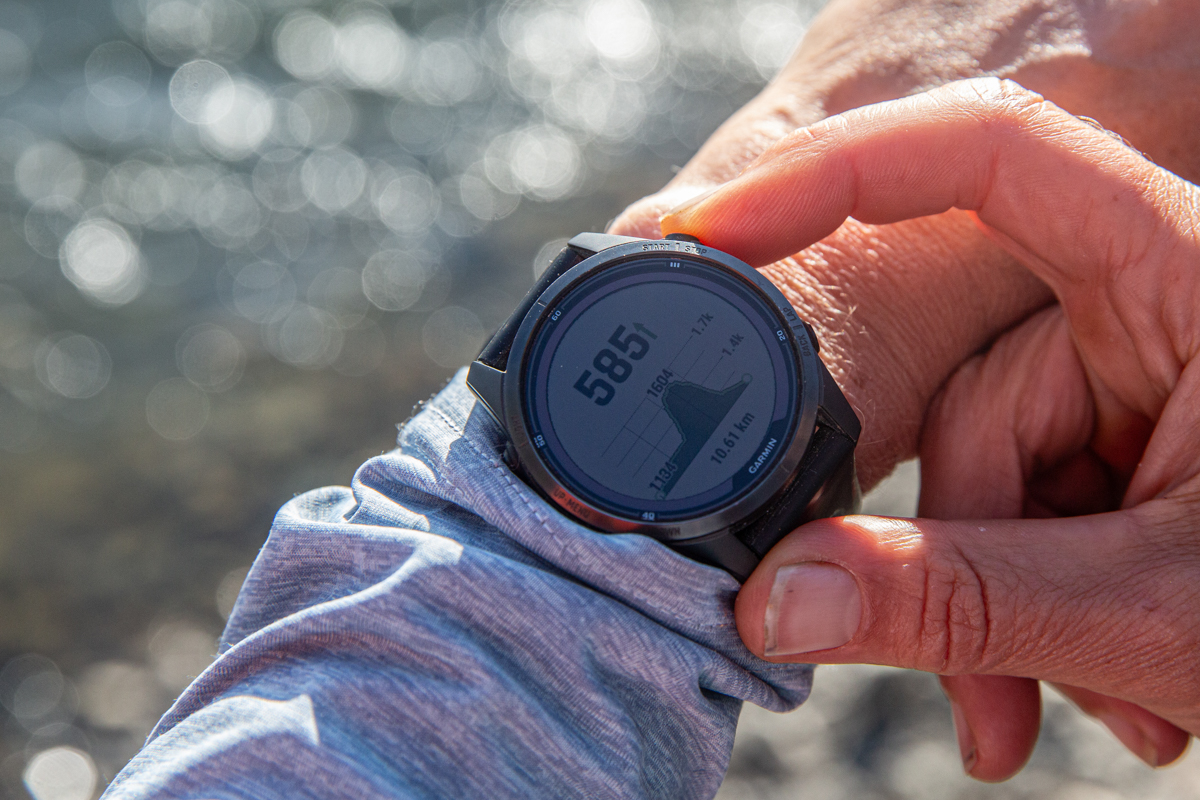
Display and User Interface
Unlike similar offerings from brands like Coros or Suunto, the Fenix 7 is fully accessible via touchscreen or side buttons. I often used a hybrid approach—disabling the touchscreen while running to avoid accidental input when adjusting my sleeves—and found both input methods intuitive. The icons are easy to interpret, and navigating is straightforward. I customized the watch face to show the data most useful to me: Each screen can hold up to eight data fields, but I kept it simple with heart rate, distance, and pace on one screen and time and map on others. I appreciated that the interface can be as detailed or streamlined as I wanted.
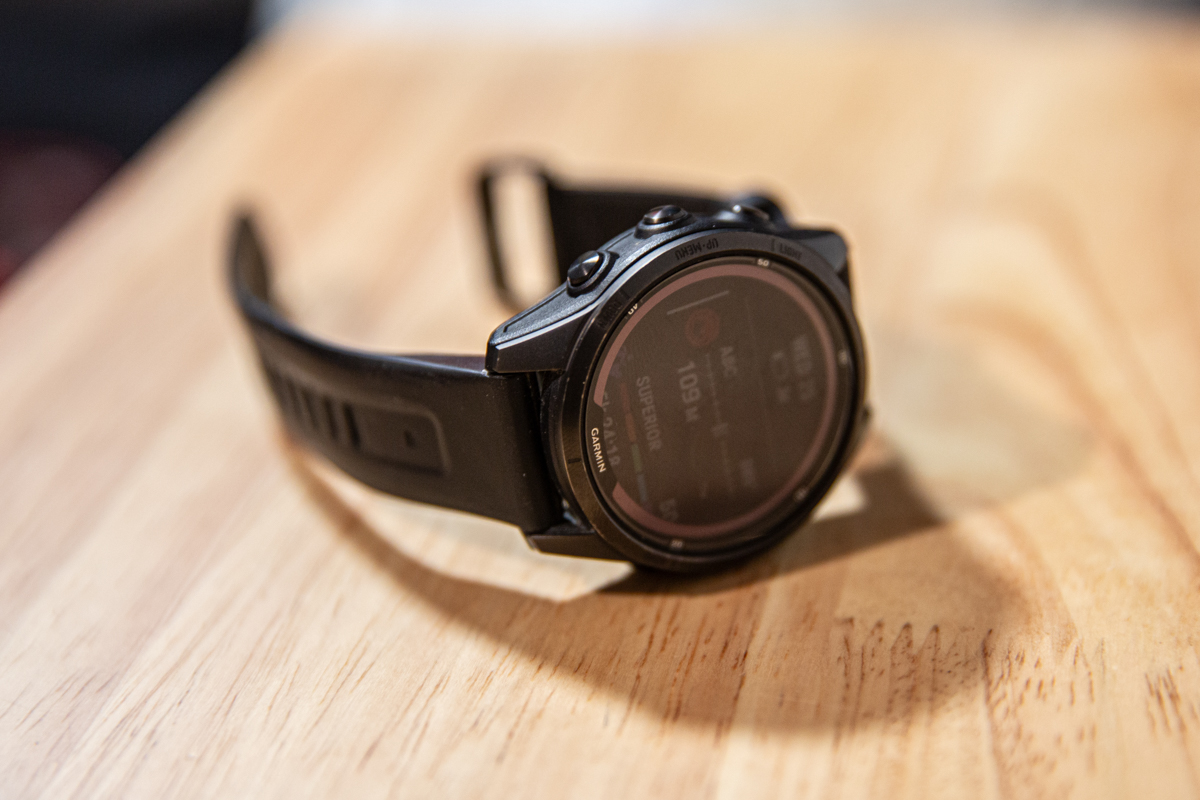
Maps and Navigation
Navigation is Garmin’s bread and butter, so it’s no surprise that the Fenix 7 Pro features one of the best map functions I’ve used. Unlike Coros’s Apex 2 Pro, which requires maps to be downloaded via computer, the Fenix comes pre-loaded. The map includes helpful markers such as street and location names and topographical contours, and it gives users the ability to set up courses and create waypoints. Navigating a course is simple as the Fenix provides directions and will notify you if you wander off track. It also provides metrics on distance traveled, distance remaining, an estimation on how long the route will take to complete, and an elevation chart. Even on my 42mm watch, the maps are easy to see, but users can zoom in on the map for greater detail. It’s also worth noting that the Fenix can navigate you back to your starting location (either with a straight line or backtracking the route), which can be a life-saving function in white-out conditions.

Key Features
Flashlight
One of the Fenix 7’s more practical features is its built-in LED flashlight, which can be activated by double-tapping the upper right-hand button. In the watch's settings, you can adjust the brightness levels or switch to a red light mode, which is useful for illuminating a tent at night without disturbing your partner. The bright white light is surprisingly powerful, though I didn’t rely on it much. To conserve battery, I typically opted for a headlamp during late-night outings.

Notifications
Like most modern smartwatches, the Fenix 7 Pro can connect to your smartphone and display notifications for calls, texts, emails, and other alerts. I didn’t use this feature often, but it’s easy to toggle off in the settings if you prefer to keep distractions at bay. And as I mentioned earlier, the Fenix 7 Pro is also compatible with Garmin’s InReach messenger, and it will display messages received via satellite.
Sleep Tracking
If you don’t mind wearing a watch to bed, the Fenix 7 Pro offers detailed sleep tracking. Using its heart rate monitor, the watch tracks your total sleep time and provides a sleep score and quality summary each morning. For those interested in more granular data, it also breaks down your time in REM, light, and deep sleep stages, as well as any time you spend awake at night. This information can influence other metrics, such as body battery and suggested daily workouts. While it's hard to verify the accuracy, I often felt the watch underestimated my REM sleep. Still, the feature offers a useful snapshot of your nightly rest.

Build Quality and Durability
If the feature set doesn’t justify the Fenix 7 Pro’s $900 price tag, its build quality might. Simply put, the Fenix 7 Pro can withstand pretty much anything you throw at it. Between its sapphire lens and titanium bezel and cover, the Fenix 7 is purpose-built to handle rough use. I’m particularly impressed with how well the watch has held up to rock climbing—even when the lens has come in contact with granite, there is not a scratch to show for it. For comparison, our tests of the Coros Apex 2 have shown that the titanium alloy cover and bezel (a titanium blend) are susceptible to scratches and gouges from rocks, but the Fenix has so far proven impenetrable. What’s more, it’s able to withstand 100 meters of water pressure, equal to that of Suunto’s scuba-specific Ocean watch.
After 5 months of consistent use, the buttons and touchscreen function as they did out of the box, and the silicone wrist band looks brand new. I haven’t had any issues with the Fenix's software to date, but Garmin continues to update the software when needed. A two-year warranty backs the watch, though damage from diamonds isn’t covered (so maybe leave the rings at home).

Other Versions of the Garmin Fenix
I tested the smallest version of the Fenix 7 (42mm), and the watch also comes in two larger sizes: a 47mm version and 51mm Fenix 7X Pro. While the 42mm and 47mm models are identical aside from size, the 7X Pro offers longer battery life (28 days in smartwatch mode; 37 with solar) and a higher screen resolution—but also comes with a steeper $1,000 price tag. It’s worth noting that Garmin has since released the Fenix 8, which improves on the 7’s battery life (21 days standard; 28 with solar), adds a brighter AMOLED display, and introduces new features like phone call support, voice commands, dive activity tracking, and leakproof buttons. However, early reviews report a buggy interface, and at $1,000 for the smallest 43mm model, we think the Fenix 7 Pro is the better overall value. That said, we’ll continue testing and report back on how the Fenix 8 performs over time.

What We Like
- Very accurate GPS tracking and boasts fully featured (and easy to use) maps and navigation functions, including pre-loaded maps.
- Already impressive battery life—11 days in default mode and 37 hours using GPS—is boosted with solar-charging capabilities.
- Seemingly endless list of activity tracking—including running, hiking, climbing, skiing, and cycling—with customizable metrics, performance summaries, and daily training suggestions.
- Fully customizable interface that can be as simple or as detailed as you want.
- Touchscreen, side buttons, and intuitive app icons make the watch easy to navigate.
- Sapphire screen and titanium bezel and cover are extremely durable, and after several months of use, all functions operate as if brand new.
What We Don’t
- Very pricey at $900 for the 42mm and 47mm sizes (and $1,000 for the 51mm size).
- Decidedly overkill for most casual users—those who aren’t looking for detailed training metrics can save a lot with simpler offerings from Garmin, Coros, or Suunto.
- While the watch itself is user-friendly, getting to know the depths of its functions comes with a steep learning curve.

Comparison Table
| Watch | Price | Weight | Battery* | Solar | Diameter(s) | Materials |
|---|---|---|---|---|---|---|
| Garmin Fenix 7 Pro Sapphire Solar | $900 | 2.6 oz. | 11 days | Yes | 42, 47, 51mm | Titanium/sapphire |
| Garmin Enduro 3 | $900 | 2.2 oz. | 36 days | Yes | 51mm | Titanium/sapphire |
| Garmin Instinct 2 Solar | $400 | 1.9 oz. | 28 days | No | 40, 45, 50mm | Glass/polymer |
| Suunto Vertical Titanium Solar | $700 | 2.6 oz. | 30 days | Yes | 49mm | Titanium/sapphire |
| Coros Vertix 2S | $699 | 3.1 oz. | 36 days | No | 50.3mm | Titanium/sapphire |
*Editor’s note: The stated battery life is the manufacturer’s claim while in default smartwatch mode (without solar charging). Changes to the settings, features, and type of tracking will affect this number.
The Competition
While Garmin’s Fenix 7 Pro is among our favorite GPS watches, there's no shortage of options to choose from. Within Garmin’s ecosystem, the Enduro 3 strikes us as a viable alternative for those seeking more performance. The Enduro offers a substantial battery upgrade—up to 36 days in smartwatch mode and 90 days with solar—along with an AMOLED display and the same interface as the latest Fenix 8—all for the same $900 price as the Fenix 7 Pro Sapphire Solar that I tested. Alternatively, those looking for a simpler option should consider Garmin’s Instinct 2, which drops full mapping for breadcrumb navigation and trims down the activity modes. On the flip side, it delivers a competitive 28-day battery life (unlimited with solar) and will save you a sizable chunk of change, making it a great choice for backcountry users who don’t need the Fenix's advanced features.

Suunto and Coros also offer viable Fenix 7 alternatives, as well. From Suunto, the Vertical Titanium Solar closely mirrors the Fenix in materials and GPS capability and beats it on battery life with up to 30 days in smartwatch mode. However, it lacks customization in activity modes and finer map details like location names. Coros’ Vertical 2S2, also priced at $700, uses a lighter titanium alloy to cut costs and forgoes some interface polish, but it remains highly functional, handling navigation, activity tracking, and backcountry missions with ease. Like the others, it boasts excellent battery life, lasting up to 36 days in smartwatch mode. Though, we consistently prefer Garmin’s offerings for their user-friendly interface and premium build quality.
Back to the Garmin Fenix 7 Pro Review See Our GPS Watch Guide


